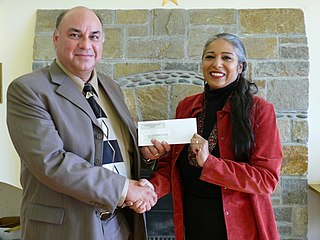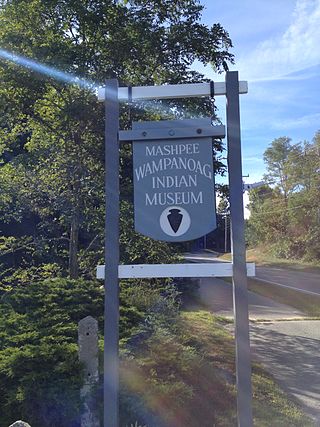Related Research Articles

Mashpee is a town in Barnstable County, Massachusetts, United States, on Cape Cod. The population was 15,060 as of 2020. The town is the site of the headquarters and most members of the Mashpee Wampanoag Tribe, one of two federally recognized Wampanoag groups.

The Native American Graves Protection and Repatriation Act (NAGPRA), Pub. L. 101-601, 25 U.S.C. 3001 et seq., 104 Stat. 3048, is a United States federal law enacted on November 16, 1990.

King Philip's War was an armed conflict in 1675–1676 between a group of indigenous peoples of the Northeastern Woodlands, the English New England Colonies and their indigenous allies. The war is named for Metacom, the Pokanoket chief and sachem of the Wampanoag who adopted the English name Philip because of the friendly relations between his father Massasoit and the Plymouth Colony. The war continued in the most northern reaches of New England until the signing of the Treaty of Casco Bay on April 12, 1678.

The Wampanoag, also rendered Wôpanâak, are a Native American people of the Northeastern Woodlands currently based in southeastern Massachusetts and formerly parts of eastern Rhode Island. Their historical territory includes the islands of Martha's Vineyard and Nantucket.

The Pokanoket was the village governed by Massasoit. The term broadened to refer to all peoples and lands governed by Massasoit and his successors, which were part of the Wampanoag people in what is now Rhode Island and Massachusetts.

The Massachusett language is an Algonquian language of the Algic language family that was formerly spoken by several peoples of eastern coastal and southeastern Massachusetts. In its revived form, it is spoken in four communities of Wampanoag people. The language is also known as Natick or Wôpanâak (Wampanoag), and historically as Pokanoket, Indian or Nonantum.

The Massachusett were a Native American tribe from the region in and around present-day Greater Boston in the Commonwealth of Massachusetts. The name comes from the Massachusett language term for "At the Great Hill," referring to the Blue Hills overlooking Boston Harbor from the south.
Praying Indian is a 17th-century term referring to Native Americans of New England, New York, Ontario, and Quebec who converted to Christianity either voluntarily or involuntarily. Many groups are referred to by the term, but it is more commonly used for tribes that were organized into villages. The villages were known as praying towns and were established by missionaries such as the Puritan leader John Eliot and Jesuit missionaries who established the St. Regis and Kahnawake and the missions among the Huron in western Ontario.

The Old Indian Meeting House is a historic meeting house at 410 Meetinghouse Road in Mashpee, Massachusetts. Built in 1758, the meetinghouse is the oldest Native American church in the eastern United States. The building was listed on the National Register of Historic Places in 1998.

The Avant House, also known as the Timothy Pocknet Homestead is an historic house on Massachusetts Route 130 at Mill Pond in Mashpee, Massachusetts. Built in the late 18th or early 19th century, it is one of the town's oldest surviving buildings. It is now owned and operated by the Mashpee Wampanoag tribe as the Mashpee Wampanoag Indian Museum. It was listed on the National Register of Historic Places in 1998.

Native American tribes in Massachusetts are the Native American tribes and their reservations that existed historically and those that still exist today in what is now the Commonwealth of Massachusetts. A Narragansett term for this region is Ninnimissinuok.
The Mashpee Wampanoag Tribe is one of two federally recognized tribes of Wampanoag people in Massachusetts. Recognized in 2007, they are headquartered in Mashpee on Cape Cod. The other Wampanoag tribe is the Wampanoag Tribe of Gay Head (Aquinnah) on Martha's Vineyard.
Joan Tavares Avant, also known as Granny Squannit, is an educator, Mashpee Wampanoag tribal leader, historian, and writer living in Mashpee, Massachusetts. Avant served as the Mashpee Public School Director of Indian Education and was a founding Trustee of the Wôpanâak language immersion program. As a tribal leader, Avant has served as Tribal President, Tribal Housing Commissioner, Clan Mother, and Professional Tribal Elder. Her writer's credits include a long-running column in the Mashpee Enterprise, editing the National League of American Pen Women's newsletter, and People of the First Light (2010).

Mashpee Wampanoag Indian Museum is a cultural center in the town of Mashpee in Barnstable County, Massachusetts, United States. The town of Mashpee is the location of the Mashpee Wampanoag Tribe, one of the two federally recognized representative bodies of the Wampanoag people. The museum ground itself is well known for the Avant House as well as hosting the Mill Pond Herring Ladder, a Fish ladder on the Mashpee River. Establishing the museum was a passion project of Amelia Peters Bingham. The idea for the museum first came in 1970, but the building was only transferred to the Wampanoag Tribal Council after a unanimous vote to do so during the Mashpee town government's annual meeting in 1997. Since 1999 the site has been listed under the National Register of Historic Places.
The Massachusett dialects, as well as all the Southern New England Algonquian (SNEA) languages, could be dialects of a common SNEA language just as Danish, Swedish and Norwegian are mutually intelligible languages that essentially exist in a dialect continuum and three national standards. With the exception of Massachusett, which was adopted as the lingua franca of Christian Indian proselytes and survives in hundreds of manuscripts written by native speakers as well as several extensive missionary works and translations, most of the other SNEA languages are only known from fragmentary evidence, such as place names. Quinnipiac (Quiripey) is only attested in a rough translation of the Lord's Prayer and a bilingual catechism by the English missionary Abraham Pierson in 1658. Coweset is only attested in a handful of lexical items that bear clear dialectal variation after thorough linguistic review of Roger Williams' A Key into the Language of America and place names, but most of the languages are only known from local place names and passing mention of the Native peoples in local historical documents.

The history of Dedham, Massachusetts from 1700 to 1799 saw the town become one of the largest and most influential country towns in Massachusetts. As the population grew and residents moved to outlying areas of the town, battles for political power took place. Similar battles were taking place within the churches, as liberal and conservative factions bristled at paying for ministers with whom they had differences of theological opinion. New parishes and preciencts were formed, and eventually several new towns broke away.
The Indian burial ground trope is frequently used to explain supernatural events and hauntings in American popular culture. The trope gained popularity in the 1980s, making multiple appearances in horror film and television after its debut in The Amityville Horror (1979). Over time the Indian burial ground trope has become viewed as a cliche and in its current usage it commonly functions as a satirical element.
The Herring Pond Wampanoag Tribe is a cultural heritage group that claims descent from the Wampanoag people based in Plymouth, Massachusetts. They have a nonprofit organization, the Herring Pond Wampanoag Tribal Council, Inc.
References
- 1 2 3 4 5 6 7 8 National Park Service (August 3, 2020). "Notice of Inventory Completion: Warren Anatomical Museum, Harvard University, Boston, MA" . Retrieved June 29, 2023.
- 1 2 3 4 5 6 7 8 9 10 11 12 13 14 15 16 Speyer Besancon, Rachel. "Alexander Quapish". Natick Historical Society. Retrieved June 29, 2023.
- 1 2 3 4 5 6 7 8 9 10 11 12 13 14 15 Gries, Gloria (December 4, 2020). "NEEDHAM HISTORY: Alexander Quapish, a Native American soldier of the Revolutionary War". The Needham Times. Retrieved June 29, 2023.
- 1 2 3 4 5 6 7 8 Tortora, Daniel J. (February 4, 2015). "INDIAN PATRIOTS FROM EASTERN MASSACHUSETTS: SIX PERSPECTIVES". Journal of the American Revolution. Retrieved June 29, 2023.
- 1 2 3 4 5 6 7 8 "Alexander Quapish". National Park Service. Retrieved June 29, 2023.
- 1 2 3 4 5 6 7 Schwan, Henry (November 25, 2020). "244-year-old remains to be moved from museum to Natick Praying Indian Burial Ground". Metrowest Daily News. Retrieved June 29, 2023.
- 1 2 3 4 5 Brown, Bob (November 24, 2020). "A Native American war veteran's long journey home to Natick burial ground". Natick Report. Retrieved June 29, 2023.
- 1 2 Coughlin, Gail. "Dedham's Indigenous Histories" (PDF). Dedham Museum and Archive . Retrieved June 29, 2023.
- 1 2 Desmond, Cameron; Diaz, Muneca; Galdamez, Marilyn; Lopez, Marcos; Mejia, Daniel; Picazopalacio, Arlette (June 25, 2010). Patriots of Color Alexander Quapish . Retrieved June 30, 2023.
- 1 2 "The remains of a Native American, who fought in the Revolutionary War, to be buried in Natick". Boston.com. Associate Press. November 28, 2020. Retrieved June 29, 2023.
![]() This article incorporates text from this source, which is in the public domain : https://www.nps.gov/people/alexander-quapish.htm
This article incorporates text from this source, which is in the public domain : https://www.nps.gov/people/alexander-quapish.htm